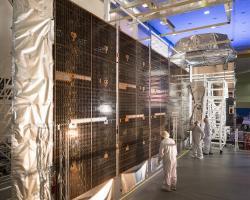Releases
SUNNYVALE, Calif., April 24, 2017 /PRNewswire/ -- The fifth Lockheed Martin (NYSE-LMT)-built Mobile User Objective System (MUOS-5) satellite is now delivering secure, beyond-line-of-sight communications to troops with legacy Ultra High Frequency (UHF) radios.
The U.S. Navy, working with Army Forces Strategic Command, configured one of MUOS-5's two communications payloads – its legacy UHF payload – to provide additional support for the Navy's legacy UHF satellite communications mission. Today, narrowband UHF communications is used by every Combatant Command in aircraft, ships, submarines, ground vehicles, as well as by troops in the field and special operations.
Eventually, legacy narrowband UHF communications will transition to next generation Wideband Code Division Multiple Access (WCDMA) capabilities provided by MUOS. To facilitate that transition, MUOS was intentionally designed with two communications payloads.
"Each MUOS satellite can simultaneously support both new WCDMA waveform capabilities and legacy UHF satellite communications," explained Mark Woempner, director of Narrowband Communications Systems at Lockheed Martin. "With MUOS 1-4 already on orbit providing near global WCDMA coverage, MUOS-5 will actively support legacy UHF communications and serve as an on-orbit WCDMA spare."
MUOS-5 is the latest edition to a network of orbiting satellites and relay ground stations that is revolutionizing communications for mobile forces. Users with new MUOS terminals will be able to seamlessly connect beyond line-of-sight around the world and into the Global Information Grid, as well as into the Defense Switched Network. MUOS' capabilities include simultaneous, crystal-clear voice, video and mission data over a secure high-speed Internet Protocol-based system.
More than 55,000 currently fielded radio terminals can be upgraded to be MUOS-compatible, with many of them requiring just a software upgrade.
Once fully operational, MUOS will provide users with more than 10 times the communications capacity of the legacy system it will replace. The network provides near-global coverage, including communications into polar regions. MUOS also has demonstrated successful communication of Integrated Broadcast Service (IBS) messages to in-flight test aircraft.
"The industry team for MUOS is an incredible partnership. Next for MUOS, we are laser-focused on bringing the complete system to full operational capability for the Navy," said Woempner. "Early combatant commander testing began in July 2016, and we have already received valuable user feedback and are working to rapidly incorporate their needs into the system."
MUOS-5 begins this transition after successful completing post-launch, on-orbit testing on January 19. The satellite completed orbit raising and successfully deployed its solar arrays and antennas for mission operations on Oct. 30, 2016.
Originally launched on June 24, 2016, MUOS-5 experienced an anomaly with its orbit raising propulsion system on its way to geosynchronous orbit. The Navy and Lockheed Martin engineering teams were able to isolate the issue and deliver MUOS to operational orbit using alternative propulsion.
The Navy's Program Executive Office for Space Systems and its Communications Satellite Program Office responsible for the MUOS program are based in San Diego, California. Lockheed Martin assembled and tested all five now-on-orbit MUOS satellites at its Sunnyvale, California, facility.
For additional MUOS information, photos and video visit: www.lockheedmartin.com/muos
About Lockheed Martin
Headquartered in Bethesda, Maryland, Lockheed Martin is a global security and aerospace company that employs approximately 97,000 people worldwide and is principally engaged in the research, design, development, manufacture, integration and sustainment of advanced technology systems, products and services.
SOURCE Lockheed Martin


